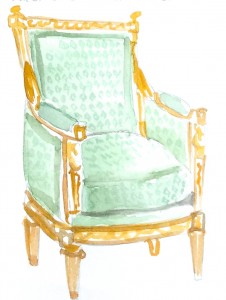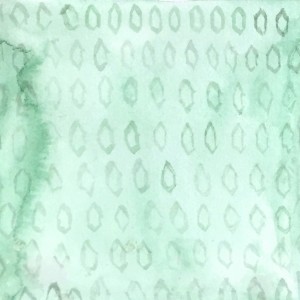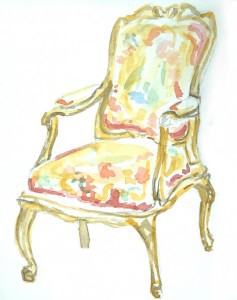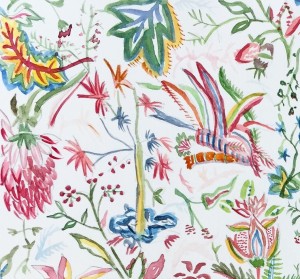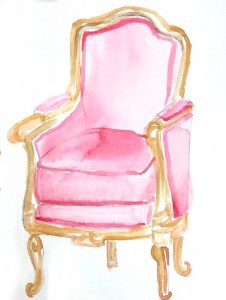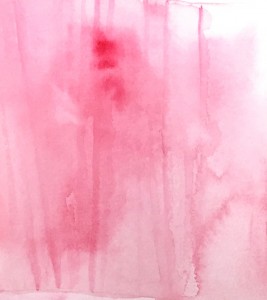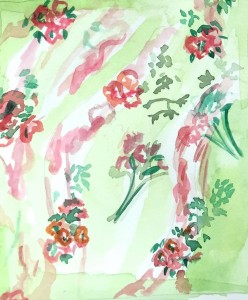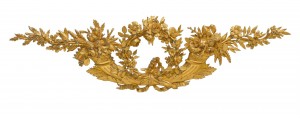SELF-FASHIONING OF THE HOME AT EVERY PRICE LEVEL
The original watercolor illustrations in this section reveal the various types of upholstery fabrics whilst maintaining the artistic novelty of 18th century representational techniques.
Armchair (bergère en cabriolet), 1788
Jean–Baptiste–Claude Sené (French, 1748–1803)
Carved, painted, and gilded walnut; H. 39 x W. 27 1/4 x D. 25 1/4 in. (99.1 x 69.2 x 64.1 cm)
Gift of Ann Payne Blumenthal, 1941 (41.205.2)
This armchair, which was part of a set of twelve, was originally upholstered with material that was embroidered by the queen herself. The frame of the bergère, which is a French term for an armchair, is finely carved with acanthus and ivy leaves, rosettes, and—on the arm supports—Egyptian term figures. The back rail is crowned by a cartouche with the initials of Marie Antoinette.
Armchair (part of a large set), 1753
Nicolas–Quinibert Foliot (French, 1706–1776)
Carved and gilded beechwood, covered with the original silk and wool Beauvais tapestry covers; H. 41 7/8 x W. 30 1/2 x D. 25 1/2 in. (106.4 x 77.5 x 64.8 cm)
The frame: Purchase, Martha Baird Rockefeller Gift, 1966 (66.60.2)
The tapestry covers: Gift of John D. Rockefeller, Jr., 1935 (35.145.26a, .25b, .23c,d)
This chair exemplifies the global trade of furniture to Paris from all over Europe for the enrichment of palaces and mansions. The chair was commissioned in a set of twelve armchairs for the Danish ambassador to the court of Versailles’s house in Copenhagen. The tapestry covers are woven with animal and bird subjects after designs by the painter Jean-Baptiste Oudry (1686–1755).
Fleurs Tropicales et Palmiers
Armchair (bergère en cabriolet) (one of a pair), ca. 1760–70
Stamped by Claude–Louis Burgat (French, 1717–before 1782)
Carved and gilded beechwood; H. 34 1/2 x W. 23 X D. 22 in. (87.6 x 58.4 x 55.9 cm)
The Jack and Belle Linsky Collection, 1982 (1982.60.89)
The closed area between the arms and the seat, together with the concave back, classify it as a bergère en cabriolet, one of the new types of chair introduced during the eighteenth century that was revolutionary in its comfort and informality.
“Another mistaken notion about eighteenth-century upholstery that still persists today is the belief that only pale or pastel colors were used for silks in the eighteenth century.”[1]
[1] Cooke, Edward S. Upholstery in America & Europe: From the Seventeenth Century to World War I. New York: Norton, 1987. Print.
This chair was upholstered in a bright pink tone.
Brocaded silk, 1760s
French
Silk and metal thread; 41 x 21 1/4 in. (104.1 x 54 cm)
Rogers Fund, 1969 (69.79.3)
The textile would have been used for dresses and contains six different metal-wrapped threads, plus twelve colors of silk. The layering of side-by-side streamers with floral sprays and garlands is typical of the 1760s.
Prior to the Industrial Revolution, the creation of patterned silk required an extremely skilled weaver and large investment in equipment and raw materials.
